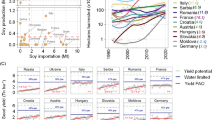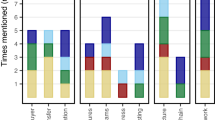Abstract
The European Union (EU) livestock sector relies on imported soybean as a feed source, but feeding soybean to animals leads to a loss of macronutrients compared to direct human consumption, and soybean production is associated with deforestation. Here we show that 75–82% of current EU animal fat and protein production could be sustained without soybean imports while avoiding increased use of cropland for feed production within the EU. Reduced soybean feed exports, mainly from South America, would free up 11–14 million hectares outside the EU, but indirect land-use changes would increase demand for palm oil produced in southeast Asia. Avoiding imported soybean feeds would result in reduced EU pork and poultry production; increased plant-based food consumption would be required to maintain the supply of essential nutrients for human diets. Optimizing livestock production to overcome dependency on imported soybean feed can reduce cropland demand in deforestation-prone areas while supporting the nutritional requirements of EU diets—but will require progressive policies targeting all aspects of the food system.
This is a preview of subscription content, access via your institution
Access options
Access Nature and 54 other Nature Portfolio journals
Get Nature+, our best-value online-access subscription
$29.99 / 30 days
cancel any time
Subscribe to this journal
Receive 12 digital issues and online access to articles
$119.00 per year
only $9.92 per issue
Buy this article
- Purchase on Springer Link
- Instant access to full article PDF
Prices may be subject to local taxes which are calculated during checkout





Similar content being viewed by others
Data availability
Data supporting the findings of this work are available in the Supplementary Data.
Code availability
All computer code needed to run the optimization model and generate data presented here is available from the corresponding author upon request.
References
Foley, J. A. et al. Solutions for a cultivated planet. Nature 478, 337–342 (2011).
Machovina, B., Feeley, K. J. & Ripple, W. J. Biodiversity conservation: the key is reducing meat consumption. Sci. Total Environ. 536, 419–431 (2015).
FAOSTAT Database: Food Balance Sheets (FAO, accessed 18 February 2019); http://www.fao.org/faostat/en/#data/FBS
EU Crops Market Observatory: EU Feed Protein Balance Sheet 2017/18 (EC, 2019).
Aide, T. M. et al. Deforestation and reforestation of Latin America and the Caribbean (2001–2010). Biotropica 45, 262–271 (2013).
Gasparri, N. I., Grau, H. R. & Gutiérrez Angonese, J. Linkages between soybean and neotropical deforestation: coupling and transient decoupling dynamics in a multi-decadal analysis. Glob. Environ. Change 23, 1605–1614 (2013).
Fehlenberg, V. et al. The role of soybean production as an underlying driver of deforestation in the South American Chaco. Glob. Environ. Change 45, 24–34 (2017).
Pendrill, F. et al. Agricultural and forestry trade drives large share of tropical deforestation emissions. Glob. Environ. Change 56, 1–10 (2019).
FAOSTAT Database: Crops (FAO, accessed 18 October 2019); http://www.fao.org/faostat/en/#data/QC
FAOSTAT Database: Detailed Trade Matrix (FAO, accessed 18 October 2019); http://www.fao.org/faostat/en/#data/TM
Nordborg, M., Cederberg, C. & Berndes, G. Modeling potential freshwater ecotoxicity impacts due to pesticide use in biofuel feedstock production: the cases of maize, rapeseed, salix, soybean, sugar cane, and wheat. Environ. Sci. Technol. 48, 11379–11388 (2014).
Bonini, I. et al. Collapse of ecosystem carbon stocks due to forest conversion to soybean plantations at the Amazon-Cerrado transition. For. Ecol. Manag. 414, 64–73 (2018).
Farm to Fork Strategy—For a Fair, Healthy and Environmentally-Friendly Food System (EC, 2020).
Report from the Commission to the Council and the European Parliament on the Development of Plant Proteins in the European Union Report No. COM(2018) 757 (EC, 2018).
Muller, A. & Bautze, L. Agriculture and Deforestation. The EU Common Agricultural Policy, Soy, and Forest Destruction. Proposals for Reform (FERN, 2017).
Deppermann, A. et al. The market impacts of shortening feed supply chains in Europe. Food Secur. 10, 1401–1410 (2018).
Henseler, M. et al. On the asynchronous approvals of GM crops: potential market impacts of a trade disruption of EU soy imports. Food Policy 41, 166–176 (2013).
Hörtenhuber, S. J., Lindenthal, T. & Zollitsch, W. Reduction of greenhouse gas emissions from feed supply chains by utilizing regionally produced protein sources: the case of Austrian dairy production. J. Sci. Food Agric. 91, 1118–1127 (2011).
Weightman, R. M., Cottrill, B. R., Wiltshire, J. J. J., Kindred, D. R. & Sylvester‐Bradley, R. Opportunities for avoidance of land‐use change through substitution of soya bean meal and cereals in European livestock diets with bioethanol coproducts. GCB Bioenergy 3, 158–170 (2011).
Sasu-Boakye, Y., Cederberg, C. & Wirsenius, S. Localising livestock protein feed production and the impact on land use and greenhouse gas emissions. Animal 8, 1339–1348 (2014).
van Zanten, H. H. E., Bikker, P., Mollenhorst, H., Meerburg, B. G. & de Boer, I. J. M. Environmental impact of replacing soybean meal with rapeseed meal in diets of finishing pigs. Animal 9, 1866–1874 (2015).
Schmidt, J. H. & Weidema, B. P. Shift in the marginal supply of vegetable oil. Int. J. Life Cycle Assess. 13, 235 (2007).
Karlsson, J. O. & Röös, E. Resource-efficient use of land and animals—environmental impacts of food systems based on organic cropping and avoided food-feed competition. Land Use Policy 85, 63–72 (2019).
van Hal, O. et al. Upcycling food leftovers and grass resources through livestock: impact of livestock system and productivity. J. Clean. Prod. 219, 485–496 (2019).
The Future of Food and Agriculture—Alternative Pathways to 2050 1–224 (FAO, 2018).
Reheul, D., De Cauwer, B. & Cougnon, M. in Fodder Crops and Amenity Grasses (eds Beat B. et al.) 1–12 (Springer, 2010).
Khan, N. A., Yu, P., Ali, M., Cone, J. W. & Hendriks, W. H. Nutritive value of maize silage in relation to dairy cow performance and milk quality. J. Sci. Food Agric. 95, 238–252 (2015).
Lüscher, A., Mueller-Harvey, I., Soussana, J. F., Rees, R. M. & Peyraud, J. L. Potential of legume-based grassland–livestock systems in Europe: a review. Grass Forage Sci. 69, 206–228 (2014).
Rohrmann, S. et al. Meat consumption and mortality–results from the European Prospective Investigation into Cancer and Nutrition. BMC Med. 11, 63 (2013).
Willett, W. et al. Food in the Anthropocene: the EAT–Lancet Commission on healthy diets from sustainable food systems. Lancet https://doi.org/10.1016/S0140-6736(18)31788-4 (2019).
Anderson, J. W., Johnstone, B. M. & Cook-Newell, M. E. Meta-analysis of the effects of soy protein intake on serum lipids. New Engl. J. Med. 333, 276–282 (1995).
Xu, W. H. et al. Soya food intake and risk of endometrial cancer among Chinese women in Shanghai: population based case-control study. Br. Med. J. 328, 1285–1288 (2004).
Rippin, H. L., Hutchinson, J., Jewell, J., Breda, J. J. & Cade, J. E. Adult nutrient intakes from current national dietary surveys of European populations. Nutrients 9, 1288, https://doi.org/10.3390/nu9121288 (2017).
Ritchie, H., Reay, D. S. & Higgins, P. Beyond calories: a holistic assessment of the global food system. Front. Sustain. Food Syst. https://doi.org/10.3389/fsufs.2018.00057 (2018).
Van Zanten, H. H. E. et al. Defining a land boundary for sustainable livestock consumption. Glob. Change Biol. https://doi.org/10.1111/gcb.14321 (2018).
Muller, A. et al. Strategies for feeding the world more sustainably with organic agriculture. Nat. Commun. 8, 1290 (2017).
Erb, K.-H. et al. Exploring the biophysical option space for feeding the world without deforestation. Nat. Commun. 7, 11382 (2016).
FAOSTAT Database: Live Animals (FAO, accessed 18 February 2019); http://www.fao.org/faostat/en/#data/QA
FAOSTAT Database: Livestock Primary (FAO, accessed 18 February 2019); http://www.fao.org/faostat/en/#data/QL
Britz, W. & Witzke, P. CAPRI Model Documentation 2014 https://www.capri-model.org/docs/capri_documentation.pdf (2014).
FAOSTAT Database: Trade - Crops and Livestock Products (FAO, accessed 18 October 2019); http://www.fao.org/faostat/en/#data/TP
Eurostat Database: Supply, Transformation and Consumption of Renewables and Wastes (EC, accessed 17 June 2019); https://appsso.eurostat.ec.europa.eu/nui/show.do?dataset=nrg_cb_rw&lang=en
Kampman, B. et al. Optimal Use of Biogas from Waste Streams: an Assessment of the Potential of Biogas from Digestion in the EU beyond 2020 (EC, 2017).
Oslaj, M., Mursec, B. & Vindis, P. Biogas production from maize hybrids. Biomass Bioenergy 34, 1538–1545 (2010).
Bioenergy in Germany. Facts and Figures 2019 (Fachagentur Nachwachsende Rohstoffe, 2019).
Eurostat Database: Crop Production in EU Standard Humidity (EC, accessed 12 February 2019); https://appsso.eurostat.ec.europa.eu/nui/show.do?dataset=apro_cpsh1&lang=en
A European Strategy for the Promotion of Protein Crops (European Parliament, 2018).
Baumgartner, D., de Baan, L., Nemecek, T., Pressenda, F. & Crépon, K. Life cycle assessment of feeding livestock with European grain legumes. In Proc. 6th Int. Conf. on LCA in the Agri-Food Sector—Towards a Sustainable Management of the Food Chain (eds Nemecek, T. & Gaillard, G.) 352–359 (Agroscope Reckenholz-Tänikon Research Station ART, 2009).
Borreani, G., Tabacco, E., Schmidt, R. J., Holmes, B. J. & Muck, R. E. Silage review: factors affecting dry matter and quality losses in silages. J. Dairy Sci. 101, 3952–3979 (2018).
Kertz, A. F. Variability in delivery of nutrients to lactating dairy cows. J. Dairy Sci. 81, 3075–3084 (1998).
Dalgaard, R. et al. LCA of soybean meal. Int. J. Life Cycle Assess. 13, 240 (2007).
Ekvall, T. & Weidema, B. P. System boundaries and input data in consequential life cycle inventory analysis. Int. J. Life Cycle Assess. 9, 161–171 (2004).
EU Crops Market Observatory: EU Feed Protein Balance Sheet 2016/17 (EC, 2019).
EU Crops Market Observatory: EU Feed Protein Balance Sheet 2015/16 (EC, 2019).
EU Crops Market Observatory: EU Feed Protein Balance Sheet 2014/15 (EC, 2019).
Murphy, S. P. & Allen, L. H. Nutritional importance of animal source foods. J. Nutr. 133, 3932S–3935S (2003).
Clune, S., Crossin, E. & Verghese, K. Systematic review of greenhouse gas emissions for different fresh food categories. J. Clean. Prod. 140, 766–783 (2017).
Wilkinson, J. M. Re-defining efficiency of feed use by livestock. Animal 5, 1014–1022 (2011).
European Food Safety Authority Dietary reference values for nutrients Summary report. EFSA Supporting Publications 14, e15121E (2017).
Eurostat Database: Population on 1 January by Age and Sex (European Commission, accessed 15 September 2019); https://appsso.eurostat.ec.europa.eu/nui/show.do?dataset=demo_pjan&lang=en
Institute of Medicine Dietary Reference Intakes: A Risk Assessment Model for Establishing Upper Intake Levels for Nutrients (National Academies Press, 1998).
Special Eurobarometer 246: Health and Food (European Parliament, 2006).
Acknowledgements
We thank L. Höglind and T. Jansson for assistance with accessing CAPRI model data and M. Lindberg and E. Ivarsson for their expertise in animal diets and nutrition.
Author information
Authors and Affiliations
Contributions
J.O.K., E.R. and P.-A.H. conceptualized the work. J.O.K. led the work, collected data and programmed the main model. A.P. programmed the sub-model calculating the nutritional composition of different food items. All authors contributed to analysing and interpreting results and writing the paper.
Corresponding author
Ethics declarations
Competing interests
The authors declare no competing interests.
Additional information
Peer review information Nature Food thanks Alexander Gocht and the other, anonymous, reviewer(s) for their contribution to the peer review of this work.
Publisher’s note Springer Nature remains neutral with regard to jurisdictional claims in published maps and institutional affiliations.
Supplementary information
Supplementary Information
Supplementary Figs. 1–5, Discussion and Tables 1–6.
Supplementary Data
Model output data and calculations made to produce figures and in-text results.
Rights and permissions
About this article
Cite this article
Karlsson, J.O., Parodi, A., van Zanten, H.H.E. et al. Halting European Union soybean feed imports favours ruminants over pigs and poultry. Nat Food 2, 38–46 (2021). https://doi.org/10.1038/s43016-020-00203-7
Received:
Accepted:
Published:
Issue Date:
DOI: https://doi.org/10.1038/s43016-020-00203-7



